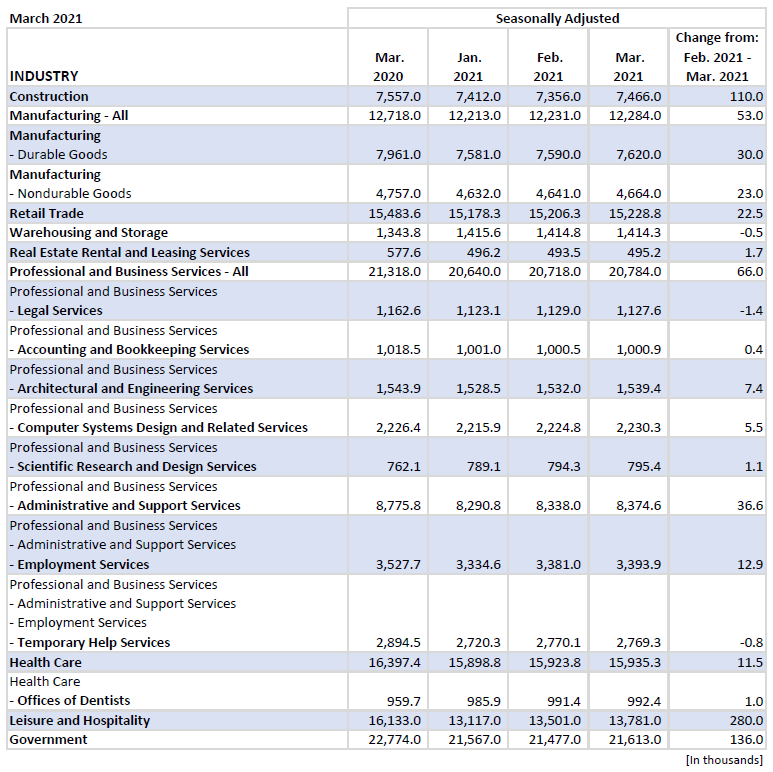In this monthly blog post we’ll report on BLS Employment Situation data as it is released, for these industries: construction, manufacturing (including durable and non-durable goods), retail trade, warehousing and storage, real estate rental and leasing services, professional and business services (including legal services, accounting and bookkeeping services, architectural and engineering services, computer systems design and related services, and scientific research and design services, administrative and support services, and administrative support services – employment services), health care (including offices of dentists), leisure and hospitality, and government.
You can always find the full Employment Situation report on the BLS website.
Total nonfarm payroll employment rose by 916,000 in March, and the unemployment rate edged down to 6.0 percent, the U.S. Bureau of Labor Statistics reported today. These improvements in the labor market reflect the continued resumption of economic activity that had been curtailed due to the coronavirus (COVID-19) pandemic. Job growth was widespread in March, led by gains in leisure and hospitality, public and private education, and construction. The unemployment rate edged down to 6.0 percent in March. The rate is down considerably from its recent high in April 2020 but is 2.5 percentage points higher than its pre-pandemic level in February 2020. The number of unemployed persons, at 9.7 million, continued to trend down in March but is 4.0 million higher than in February 2020.

BLS Summaries by Industry
Construction: Construction added 110,000 jobs in March, following job losses in the previous month (-56,000) that were likely weather-related. Employment growth in the industry was widespread in March, with gains of 65,000 in specialty trade contractors, 27,000 in heavy and civil engineering construction, and 18,000 in construction of buildings. Employment in construction is 182,000 below its February 2020 level.
Manufacturing: Manufacturing employment rose by 53,000 in March, with job gains occurring in both durable goods (+30,000) and nondurable goods (+23,000). Employment in manufacturing is down by 515,000 since February 2020.
Retail Trade: Retail trade added 23,000 jobs in March. Job growth in clothing and clothing accessories stores (+16,000), motor vehicle and parts dealers (+13,000), and furniture and home furnishing stores (+6,000) was partially offset by losses in building material and garden supply stores (-9,000) and general merchandise stores (-7,000). Employment in retail trade is 381,000 below its February 2020 level.
Warehousing and Storage: N/A
Real Estate Rental and Leasing Services: N/A
Professional and Business Services: Employment in professional and business services rose by 66,000 over the month but is down by 685,000 since February 2020. In March, employment in administrative and support services continued to trend up (+37,000), although employment in its temporary help services component was essentially unchanged. Employment also continued on an upward trend in management and technical consulting services (+8,000) and in computer systems design and related services (+6,000).
Health Care: Employment in health care changed little in March.
Leisure and Hospitality: In March, employment in leisure and hospitality increased by 280,000, as pandemic-related restrictions eased in many parts of the country. Nearly two-thirds of the increase was in food services and drinking places (+176,000). Job gains also occurred in arts, entertainment, and recreation (+64,000) and in accommodation (+40,000). Employment in leisure and hospitality is down by 3.1 million, or 18.5 percent, since February 2020.
Government: N/A

